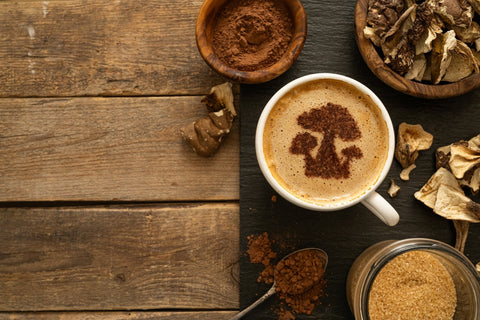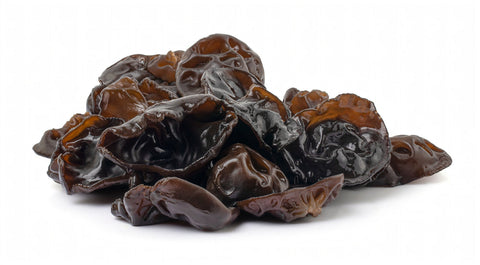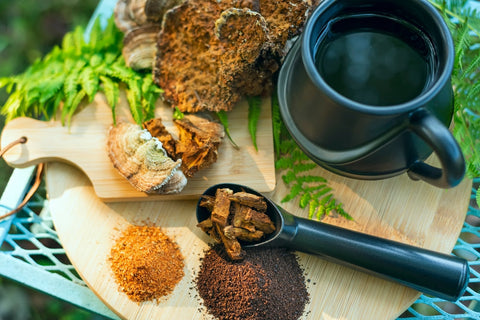Curious about the latest wellness trend taking over mugs around the world? Mushroom coffee blends the familiar warmth of roasted coffee with the powerful bio-actives found in functional mushrooms. This guide covers everything a first-time drinker needs to know—from health benefits and taste to how it's brewed.
1. What is mushroom coffee?
Mushroom coffee is a regular ground-coffee blend that has been fortified with concentrated extracts of functional mushrooms—most often Lion’s Mane, Chaga, Cordyceps, and Reishi. The beans are roasted and ground as usual, then a measured amount of mushroom extract powder is mixed in before packaging.
Because the mushroom powder replaces a portion of the coffee grounds, a typical serving delivers about half the caffeine of standard drip coffee while adding beta-glucans, hericenones, triterpenes, cordycepin, and other bio-actives associated with sharper focus, antioxidant support, balanced energy, and stress modulation. You brew it exactly like any other ground coffee—French press, pour-over, drip machine, AeroPress, moka pot, or cold-brew jar all work. [1][2]
Curious how mushroom coffee compares to your regular brew? Check out Mushroom Coffee vs. Regular Coffee: Why the “Kick” Feels Different.
2. How much caffeine is in a cup?
Most commercial blends contain 40–60 mg of caffeine per 8‑oz cup—about half the 95 mg in a standard drip brew and far more than decaf’s 2–5 mg. The lower dose, paired with adaptogenic compounds, helps explain why many drinkers report steady energy with fewer spikes and crashes. [3]
3. Does it taste like mushrooms?
Not really. Most reviews describe mushroom coffee as “regular coffee with a subtle earthy backbone.” Roasting caramelizes the beans and neutralizes any overpowering mushroom flavor. If you notice anything, it might be a gentle nuttiness. [4]
Drink it however you like—black, iced, latte, mocha. Some first-timers notice a bit of sediment at the bottom of the cup, but it’s not grainy or unpleasant. [5]
4. What science backs the claimed benefits?
- Lion’s Mane – A 16-week randomized trial showed improved memory and processing speed in older adults with mild cognitive impairment. [6]
- Chaga – 2024 lab and animal studies highlight strong antioxidant and immune‑modulating activity. [7]
- Cordyceps – A double‑blind study found a significant VO₂‑max boost after three weeks of supplementation in high‑intensity athletes. [8]
- Reishi – Clinical work in fatigue and anxiety has reported subjective improvements over placebo. [9]
Although large human trials on mushroom coffee blends are limited, research on these individual mushrooms highlights their functional value.
5. What mushrooms are used?
The most common mushrooms in coffee blends include:
- Lion’s Mane – supports brain health, focus, and memory
- Chaga – rich in antioxidants; promotes immune function
- Cordyceps – supports energy and oxygen uptake
- Reishi – known for calming and stress-supporting effects
- Shiitake – supports cardiovascular health and immune defense
- Maitake – linked to blood sugar balance and immune enhancement
- Turkey Tail – rich in polysaccharides; supports gut and immune health
- White Button – contains antioxidants and supports metabolic health
- Black Fungus – valued for cardiovascular and liver support
- Royal Sun Agaricus – researched for anti-inflammatory and anti-tumor potential
Most blends include 2–6 mushrooms. For potency, some experts recommend using no more than eight in a single blend. [10]
Want to explore more? The Health Benefits of Mushrooms: A Quick Overview
6. Is it safe for everyone?
For most healthy adults, mushroom coffee is considered low-risk. That said, you should consult a healthcare provider before drinking it if you:
- Have kidney disease or a history of kidney stones (Chaga is high in oxalates)
- Take blood thinners, immunosuppressants, or diabetes medication
- Are pregnant or breastfeeding
- Have a known mushroom allergy [11]
7. Will it upset my stomach?
Many people find mushroom coffee gentler than traditional brews, thanks to lower acidity and caffeine content. If you have a sensitive stomach, start with half a serving, pair it with food, or try a cold brew or dark roast. [11]
Discover more in Maximizing the Nutritional Benefits of Mushroom Coffee.
8. How do I brew it for best results?
- Measure – Use one rounded tablespoon (≈ 10 g) of grounds per 8 oz (240 ml) of water.
- Heat – Aim for 195–205 °F / 90–96 °C water.
- Time – Steep or drip for 3–4 minutes. With a French press, plunge gently.
- Cold Brew – Mix at a 1:8 ratio, steep for 16 hours in the fridge, and strain.
Not ready to DIY? Try a pre-made blend to get started quickly and easily.
9. Can I use my standard coffee gear?
Yes! Mushroom coffee works with French presses, pour-overs, drip machines, AeroPresses, moka pots, and reusable K‑cups. The only exception? Paper pods—they can block mushroom particles and under-extract the blend. [1]
10. Tips for first-time mushroom coffee drinkers
- Start with Pre-Made Blends – Ideal for beginners, with balanced taste and dosage. [1]
- Experiment with Ratios – Start with a 1:1 coffee-to-mushroom ratio and tweak to your taste. [2][3]
- Stir Well – Mix thoroughly to dissolve powder and reduce sediment.
- Taste Test – Explore different blends and benefits to find your favorite combo.
Not sure which form is best? Check out Exploring Mushroom Supplements: Which Is Best for You?
Summary: Should You Try Mushroom Coffee?
Mushroom coffee is a delicious and low-risk way to incorporate functional foods into your morning routine. With smoother energy, gut-friendly ingredients, and a growing body of scientific support, it’s a smart twist on a familiar brew. As long as you buy from trusted sources and listen to your body, mushroom coffee is well worth a sip. [1][4][5]
Ready to taste the difference?
Try a bag of Mushroom Kick coffee today and get cleaner energy in your very next brew.
References
- [1] https://cafely.com/blogs/recipe/mushroom-coffee
- [2] https://www.pack-secure.com/mushroom-coffee.html
- [3] https://lairdsuperfood.com/blogs/news/mushroom-coffee-boost-immunity
- [4] https://cafely.com/blogs/info/mushroom-coffee-pros-cons
- [5] https://emberk.co/blogs/learn/mushroom-coffee-everything-you-need-to-know
- [6] https://pubmed.ncbi.nlm.nih.gov/19789292/
- [7] https://www.sciencedirect.com/science/article/abs/pii/S0944711324001375
- [8] https://pubmed.ncbi.nlm.nih.gov/28612713/
- [9] https://pubmed.ncbi.nlm.nih.gov/25004864/
- [10] https://www.healthline.com/nutrition/mushroom-coffee#types
- [11] https://health.clevelandclinic.org/what-is-mushroom-coffee


